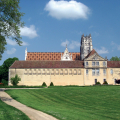ROYAL MONASTERY OF BROU
A religious complex of flamboyant gothic style, with a magnificent decoration, decorated with stone lace, richly decorated.
The Royal Monastery of Brou is a religious complex located on the southern outskirts of Bourg-en-Bresse, which was one of the capitals of the former Duchy of Savoy. A masterpiece of the flamboyant Gothic style, the monastery was built between 1506 and 1512 and its church (Saint-Nicolas-de-Tolentin de Brou) between 1513 and 1532. The monument was born of the will of a powerful woman who lived at the end of the Middle Ages: Marguerite of Austria, whose destiny was exceptional in many ways. Heiress by her mother to the duchy of Burgundy, she was the granddaughter of Charles the Bold, the last great duke of Burgundy. At the age of only 3, she was promised to the dauphin Charles VIII, son of Louis XI, in a matrimonial alliance that put an end to 15 years of war, but she was finally repudiated in favor of Anne of Brittany. The young Marguerite is then promised in second marriage to Jean d' Aragon, but this one dies prematurely a few months later. Widowed at 17, she finally married the Duke of Savoy Philibert II, known as Philibert le Beau, in 1501, in yet another diplomatic negotiation led by her father who wanted an alliance with the House of Savoy. It was a happy and successful marriage, but sadly short-lived: Philibert le Beau died in 1504 as a result of a hunting accident. Widowed for the second time, Marguerite refused any new marriage and mourned Philibert II until the end of her life. Having become the owner of several territories and the head of a large fortune following her successive marriages, Marguerite of Austria now had considerable financial means. It was to honor the memory of her late husband, and to respect the wishes of her mother-in-law, Marguerite de Bourbon, that she decided to build this monastery. She conceived it as a mausoleum, destined to house the tomb of Philibert the Handsome, then her own. The construction of the complex began in 1506 on the borders of France, at the gates of Bourg-en-Bresse, which was then part of the Duchy of Savoy. Marguerite of Austria supervised the construction from the Netherlands, where she was to assume the regency upon the death of her brother. The monument is an assertion of her power and testifies to her desire to strengthen the ties between her Burgundian heritage and the Savoyard region which she had joined by marriage. For the construction of her royal monastery, she was inspired by the Chartreuse de Champmol in Dijon, and multiplied the Burgundian emblems and references to the duchy of Burgundy. The most notable illustration of this desire to emphasize its origins is the high gabled roof, covered with glazed and colored tiles, in the Burgundian fashion. Replaced in 1759 by the sculptor Antoine-Michel Perrache, who gave the roof a mansard shape, the roof will regain its original splendor in 1998.
Beyond its architecture, which makes it a jewel of the flamboyant gothic style, the monastery of Brou is remarkable for its interior, richly decorated and very well preserved. Its beautifully decorated choir, which seems to be decorated with stone lace, houses the tombs of Philibert II, Marguerite of Austria (whose remains were installed here, alongside those of her husband in 1532, two years after his death from gangrene) and Marguerite of Bourbon, the mother of Philibert II. Their remains rest under Carrara marble recumbents, with that of Philibert II occupying the place of honor, in the middle of the choir. His tomb has the particularity of presenting two marble recumbents: the first representation showing him alive, with his eyes open, wearing the insignia of his office (he is dressed in his ermine coat and wears his crown as Duke of Savoy), and the second representation, on the lower level, shows him with his eyes closed, almost naked and waiting to be resurrected. The tomb of Marguerite of Austria is equally original, with its two recumbents installed under a monumental baldachin that recalls her imperial origins. The tombs are extraordinarily elaborate and filled with numerous well-preserved statues. In the altarpieces, the stained glass windows, and the ornamental sculptures, one finds numerous traces of the couple that Philibert II and Marguerite of Austria formed.
Unique in France, the monastery has three cloisters of different styles. In one of them, Marguerite, who had planned to end her widowhood in the monastery, had her private apartments installed. The three rooms, which she did not have time to occupy, have been refurbished and now present an exhibition space dedicated to the different aspects of her life. The monastic buildings of Brou also house the municipal museum and its rich collections of French, Flemish and Italian art from the 15th to the 20th century, including Jan de Beer's Holy Family, Bernard van Orley's Portrait of Marguerite of Austria, and Jean Jouvenet's The Fainting of Esther. Brou also has many examples of troubadour style painting and landscapes of the 19th century. Several rooms are finally dedicated to decorative art where you can discover regional furniture or Meillonnas earthenware. Everything is admirable in this monastery which invests in all publics with visits, workshops and courses of sensitization to art, archaeology and architecture. The church and the three cloisters are classified as historical monuments.
Did you know? This review was written by our professional authors.
The strengths of this establishment:
Members' reviews on ROYAL MONASTERY OF BROU
The ratings and reviews below reflect the subjective opinions of members and not the opinion of The Little Witty.
La guide était passionnante. Elle nous a permis de découvrir ce lieu magnifique.
Visite captivante d’environ une heure.
Mention pour l’hologramme de Marguerite d’Autriche.
Exposition permanente de tableaux











Parking gratuit